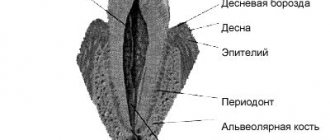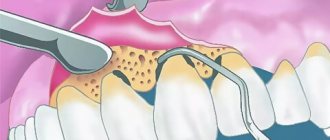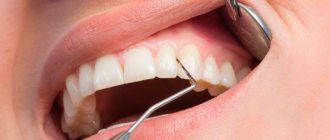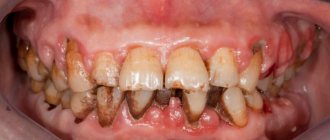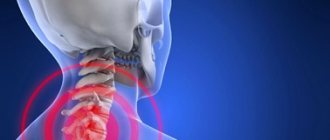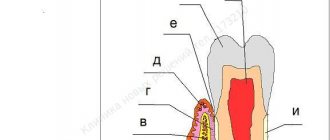Introduction
In the structure of dental care provided to citizens of the Russian Federation in recent years, the importance of restorative and rehabilitation technologies, in which physical methods of treatment play a leading role, has increased significantly.
It is known that the effect of physical factors on the body is determined by the totality of changes they cause in the physical and chemical properties of cells and the metabolic processes occurring in them, as well as by general reactions that arise in physiological functional systems under the influence of their influence and are of a neuro-reflex and humoral nature, promoting reducing treatment time and prolonging remission of the disease [1].
The state of physiotherapy is highly dynamic [2]. In practical dentistry, the search for new effective physiotherapeutic effects is constantly being carried out, methods are being developed, and new devices and devices are being created [3]. Particular interest in practical dentistry is currently shown in portable physiotherapeutic devices, which can be used not only in a specially equipped physiotherapy room, but also in a dental treatment room.
Physical factors are especially effective in the complex therapy of patients with periodontal diseases, in any form, severity, chronic course and during exacerbation, helping to improve the condition of not only the oral organs, but also the body as a whole, providing immunocorrection and a healing effect [4] .
The purpose of our work is to assess the state of physiotherapeutic care in the Udmurt Republic (UR) and the commitment to physiotherapeutic methods of treatment of dentists and patients with chronic generalized periodontitis.
Physiotherapeutic treatment of gum diseases
01.10.2012 22:51Physiotherapeutic procedures have a diverse effect on the human body and have long been used in various fields of medicine, incl. and in dentistry (for gum swelling).
The mechanisms of gum disease involve disruption of the blood supply to bone tissue, i.e. there is a lack of oxygen, nutrients and useful components (hypoxia state). Therefore, in the treatment of gum diseases (gingivitis, periodontitis, periodontal disease), any methods of restoring blood supply are used that help renew the microvasculature - a network of venous, arterial and lymphatic capillaries.
Paraffin therapy
Indications for use of paraffin:
- Gum diseases (gingivitis, periodontitis, periodontal disease);
- Chronic inflammatory processes;
- Erosive and ulcerative lesions of the oral mucosa;
- Lesions of the facial or trigeminal nerve;
- Injuries to the soft tissues of the face and jaws.
Contraindications to the use of paraffin:
- Acute inflammatory processes;
- Neoplasms;
- Insufficiency of the cardiovascular system;
- Exhaustion;
- Kidney disease;
- Bleeding.
Paraffin, having a high heat capacity and low heat transfer, has a compression effect on periodontal tissue, reduces their swelling, changes local tissue metabolism, enhances tissue oxidative processes, improves the trophism and tone of the gums, stimulates reparative processes, and increases the level of local immunity.
Melted paraffin at a temperature of 50-52 °C is applied layer by layer to the dried gum using the application method. It cools quickly and forms a protective film characterized by low thermal conductivity. A thicker layer (up to 0.3 cm) is applied on top of the frozen paraffin.
The duration of the procedure, carried out daily, is 20-40 minutes, absolute painlessness, the course of treatment is 7-15 sessions.
Darsonvalization
Darsanvalization is the treatment of gums with high-frequency (100 - 300 Hz) pulsed alternating sinusoidal current of high voltage (20 kV) and low strength (0.02 mA).
This physiotherapeutic method of treating periodontitis is based on the use of high-frequency pulsed current, high voltage and low force. Darsonvalization has an analgesic effect, improves the trophism of periodontal tissues, the functional state of blood vessels, enhances the migration of leukocytes, increases tissue reactivity, thereby increasing the level of local immunity and gives a lasting positive therapeutic result for gum diseases.
Indications for the use of darsonvalization:
- Wounds and ulcers of the oral cavity;
- Jaw fracture;
- Gingivitis (catarrhal, hypertrophic);
- Periodontitis;
- Periodontal disease;
- Periodontitis;
- Glossalgia;
- Arthrosis-arthritis of the temporomandibular joint;
- Trigeminal neuralgia.
Contraindications to darsonvalization:
- Tendency to bleed.
Darsonvalization of gums (gum treatment)
carried out with the patient lying or sitting. A gingival electrode with a rubber tube attached to it is inserted into the resonator. The electrode is moved by contact along the outer surface of the gums, closer to the transitional fold, without touching the teeth. First they act on the gums of the lower and then the upper jaw.
The procedure is performed at medium power for 3-5 minutes for each jaw.
A course of 10-15 procedures.
Darsonvalization of the temporomandibular joint
is carried out with the patient lying on his side or sitting. The procedure is performed either by contact or remote technique. The latter is carried out from a distance of 0.5 - 1.0 centimeters and has a more intense effect. A small mushroom-shaped electrode is moved in a circular motion over the joint, covering about five centimeters around it. The intensity of the impact is medium or high power, the duration of the procedure is 3-5 minutes, the number of procedures is 10.
Darsonvalization of wounds and oral ulcers
is carried out with a gingival electrode, which is placed above the surface of the ulcer with an air gap of 0.3 - 0.5 centimeters and moved in a circular motion by 1-2 centimeters for 3-5 minutes. The course of treatment consists of 6 procedures with an interval of one day.
Magnetotherapy
Low-frequency magnetic therapy is the use of a low-frequency magnetic field for therapeutic purposes.
Magnetic therapy is used for neuralgia, inflammatory but not purulent processes, severe swelling of soft tissues, hematomas, injuries of the maxillofacial area, and the effect can be carried out already on the 2nd day. Postoperative wounds (bandage, plaster, metal crowns, prostheses, splints) are not a contraindication.
Indications for the use of low-frequency magnetic therapy:
- Periodontitis;
- Catarrhal gingivitis;
- Ulcerative and traumatic damage to the oral mucosa;
- Postoperative injuries and wounds;
- Acute arthritis of the temporomandibular joint.
Contraindications to the use of low-frequency magnetic therapy:
- Malignant neoplasms;
- Insufficiency of the cardiovascular system;
- Hypertonic disease;
- Pregnancy;
- Systemic blood diseases.
Impact on the temporomandibular joint
carried out by an inductor installed above the projection of the joint. In a two-way process, two inductors can be used.
The exposure mode is continuous, a half-sinusoidal field is used;
Magnetic induction intensity - 20-25 mT;
exposure time - 10 minutes for each joint;
course of treatment - 10-15 procedures.
This technique can be used for periodontal diseases.
Exposure to a low-frequency magnetic field for a fracture of the lower jaw
carried out by a rectangular or cylindrical inductor.
The mode is continuous and then pulsating (10 minutes in each mode), the shape of the magnetic field is half-sinusoidal.
The course of treatment is 10-15 procedures.
Material and methods
The assessment of the provision of physiotherapeutic care in the Urals was carried out using special questionnaires that were sent to dental institutions of the republic through the organizational and methodological department of the BUZ UR RSP of the Ministry of Health of Russia (chief doctor A.M. Bogdanov). The object of the study was healthcare institutions of various forms of ownership in Izhevsk and the Urals, accepting dental patients and giving them the opportunity to receive physiotherapeutic procedures. Monitoring of 46 institutions was carried out: 16 budgetary multidisciplinary hospitals in Izhevsk with departments and dental offices, 4 state dental clinics in Izhevsk, 16 regional healthcare institutions of the Ural Republic, where the hospitals included dentists, as well as 10 privately owned dental organizations. The study included budgetary healthcare institutions with and without a physiotherapy service (department or office). In the process of studying the physiotherapeutic service, data was recorded on physiotherapeutic equipment and types of physiotherapeutic procedures that were performed on patients for various dental diseases.
To assess the adherence of dentists to physiotherapeutic treatment and patients with chronic generalized periodontitis, special questionnaires have been developed, including basic and additional questions. Based on the answers to the first 4 main questions in the questionnaires for both doctors and patients, the level or degree of compliance with physical treatment was assessed in points in accordance with the Morisky-Green method [5-7]. Moreover, with an affirmative answer to the first, second and fourth questions and a negative answer to the third question, the respondent received a maximum score of 4, and his degree of compliance was assessed as high; when receiving 3 points, adherence (compliance) was defined as insufficient, i.e., its average level, and when receiving 2 or less points, the patient was considered non-adherent, i.e., with a low level of compliance. In addition, the degree of compliance between doctors and patients was determined using the N. Insull method.
The main questions in the questionnaire for dentists were:
— Do you consider physiotherapeutic methods effective in the treatment of periodontitis? Not really;
— Do you prescribe physical therapy to reduce the number of visits to the doctor? Not really;
— Do you prescribe physical therapy after or before professional hygiene? Before after;
— Do you prescribe physiotherapy such as Optodan, Ozone, Darsonval, electrophoresis for CGP? Not really.
Clarifying questions were: 1) “What physiotherapeutic methods do you use in the treatment of periodontal diseases?”; 2) “How many physical procedures do you prescribe?”; 3) “Do you consider physiotherapeutic methods effective as therapeutic measures?” (Yes, No, Difficult to answer); 4) “Do you consider physiotherapeutic methods effective as rehabilitation measures?” (Yes, No, Difficult to answer); 5) “Do you prescribe physiotherapeutic treatment once (one visit for a specific procedure) during the treatment of the underlying dental disease?” (Yes, No, Difficult to answer).
The questionnaire for patients included the following main questions:
— If you were prescribed physical therapy, did you complete the entire course? Not really;
— Did you interrupt your physical therapy? Not really;
— Did you follow the doctor’s recommendations for physical therapy (daily or every other day, do not go outside immediately in cold weather after the session, etc.)? Not really;
— Did you keep up with the procedure? Not really.
The clarifying question was: “For what reason did you refuse to complete the course of physical treatment?” (no time, haven’t seen results, financial difficulties, too lazy to go for procedures).
For statistical processing of the results, t
-Student's t-test, since the data distribution did not contradict the hypothesis of normal distribution.
p
was accepted as statistically significant .
Causes
Insufficient oral hygiene. Promotes the accumulation of bacteria and infection of the tissues surrounding the tooth. When the acute phase of inflammation passes, the process of periodontal destruction can continue, leading to periodontal disease.
Hereditary predisposition: pathologies of bone structure, problems with blood vessels, blood circulation, etc.
Vascular diseases. They lead to circulatory disorders, blood supply to the periodontium, and their insufficient supply of nutrients and oxygen. This provokes gradual destruction of the periodontium.
Systemic diseases: atherosclerosis, diabetes mellitus, endocrine diseases, etc.
Incorrect treatment of periodontitis. Periodontal disease can develop as a complication of too aggressive therapy if, as a result, the nutrition of the periodontium is disrupted.
Do you have questions about periodontal disease?
We will call you back within 30 seconds
+7
Symptoms
The danger of the disease is that there are no pronounced symptoms in the early stages, when it is best treated. Timely diagnosis is possible only if the patient regularly visits the dentist and undergoes periodic examinations. With the gradual development of periodontal disease, the necks of the teeth are exposed (it seems that the crowns have become “longer”), the sensitivity of the enamel increases, and an itching sensation may occur. The pathology is visible only on x-ray: the image shows a decrease in bone volume. If you do not start therapy, the fixation of the tooth will be disrupted and its root will be exposed.
Symptoms of periodontal disease change as it progresses to more complex stages:
- At the initial stage, the process occurs only in the periodontal tissues; it is not felt by the patient. During this period, slight itching and a feeling of discomfort may appear, but they quickly pass;
- if treatment is not started, the interdental septa become thinner. Itching appears more often, becomes more pronounced, pain may occur, and rarely, gum bleeding when brushing your teeth or eating hard foods. Due to the thinning of the interdental septa, pieces of food may remain in the spaces between the teeth. The color of the gums changes - they lighten and become pale. The gingival margin begins to recede, causing the necks of the teeth to become exposed. The crowns visually “lengthen” by 4-6 mm;
- in the advanced stage, atrophy of periodontal tissue occurs. Bleeding gums become constant, pain intensifies, teeth become mobile. The edge of the gum continues to descend, exposing the crowns, their visible part lengthens by 8-10 mm. The stage ends with tooth loss.
Even after this, the destructive process continues. If left unchecked, it can cause a number of serious diseases:
- osteomyelitis of the jaw bone;
- disturbance in the distribution of chewing load on the dentition;
- diseases of the digestive system;
- lymphadenitis;
- purulent intoxication, etc.
Types of periodontal disease
Depending on the nature of the disease, periodontal disease is divided into types:
- acute stage;
- chronic course.
This division is not clear in its classification, since classic external manifestations are often not observed. During the acute stage, the process occurs quickly over several years.
By area of the oral cavity affected:
- localized stage, in which the affected area includes several teeth;
- generalized lesion involving the entire upper or lower jaw, or both.
According to the stage of the disease:
- initial, when changes in tissues are noticeable only during special diagnostics;
- the first, in which there is slight receding of the gums;
- the second stage, characterized by exposure of the necks of the teeth, the appearance of interdental spaces;
- third - if the gums are lost by more than 50%, loosening of the teeth and discomfort during the chewing process is possible;
- the extreme stage, the fourth, causes the greatest discomfort, eating becomes problematic, and the teeth are extremely loose.
Forecasting. Can periodontal disease be cured?
Yes, if you received qualified and emergency care at the initial stage of the disease. And no, if moderate or severe forms of periodontal disease are diagnosed. At these stages, it is only possible to stabilize destructive processes and slow down the progression of periodontal disease.
It is impossible to ignore such an important aspect as prevention. Dental and oral hygiene is very important. At the slightest sign of gum problems, you need to contact a specialist - early detection of the disease is the key to success. For prevention, you can do a hygienic massage of the gums, use herbal infusions and decoctions to rinse the mouth, eat solid vegetables and fruits (additional massage of the gums), and to strengthen bones (including jaw bones) eat foods containing calcium and vitamins.
What is gum periodontal disease?
It is possible to diagnose this disease independently only at a significant stage of development; initial periodontal disease does not show obvious signs. At the initial stage, the dentures of the teeth begin to become exposed and increased sensitivity is observed when eating hot and cold food. But for early diagnosis of the disease, X-ray studies should be carried out, and in the pictures you can see the size of the exposed tooth roots, on which the severity of the disease depends.
Due to the fact that obvious signs of periodontal disease do not appear immediately, its progression occurs unnoticed by the patient and leads to the destruction of bone tissue, and then to disruption of the functioning of the digestive system. In the most extreme stage, complete destruction, even tooth loss, is possible.
Periodontal disease treatment
The treatment process must be comprehensive, under the supervision of a specialist.
Treatment methods include:
- use of UHF therapy, electrophoresis;
- gum massage and cleaning from plaque and stone, timely treatment of caries;
- timely removal of dead tissue;
- To reduce mobility, teeth splinting is used;
- in case of severe damage, the tooth is removed and prosthetics are prescribed;
- medication course: drugs that accelerate the regeneration of affected tissues, anti-inflammatory, multivitamin complexes.
How to treat gum periodontal disease
The treatment process is lengthy, and the individuality of the body, as well as all concomitant and chronic diseases, should be taken into account.
It is important to quit smoking, maintain oral hygiene, and eat a balanced diet. The specialist prescribes a comprehensive treatment regimen, depending on the stage of development of the disease. Drug treatment together with physiotherapy can stop the development of periodontal disease.
Oral care for periodontal disease
Oral hygiene is very important; timely brushing of teeth not only helps to destroy pathogenic bacteria, but also massages the gums, which increases blood circulation. You should pay attention to the stiffness of the brush and timely replacement, at least once every three months.
It is useful to use irrigators, which serve to wash hard-to-reach areas and gently remove food debris.
Periodontal disease is a dangerous disease that requires long-term treatment, constant monitoring by a specialist and comprehensive treatment.
Periodontal disease is...
According to the terminology of the Great Medical Encyclopedia, periodontal disease is a lesion of the periodontium of a dystrophic nature (periodontium is a complex of tissues surrounding the tooth and holding it in the alveolus, having a common origin and function).
Periodontal dystrophy is premature atrophy of the dental alveoli, characterized by progressive resorption of their bone tissue, leading to the formation of pathological periodontal pockets, suppuration from them, loosening of teeth and, often, the occurrence of alveolar abscesses. Let's bring some clarity to medical terminology. Dystrophy is the basis of the process, a violation of the complex of mechanisms (trophism) that ensure the metabolism (metabolic processes) of cells and intercellular substances and the preservation of their structure, as a result of which the function of the organ changes.
Bone resorption - in pathology - resorption of necrotic masses and reabsorption (absorption) of substances into blood or lymphatic vessels.
Alveolar abscess - formed on the alveolar process of the jaw as a result of apical purulent inflammation of the root periosteum of the tooth. The pus, which initially accumulates at the apex of the root, infects the cell and causes inflammation of the bone marrow of its walls.
Features of the treatment of periodontitis and periodontal disease
At the same time, the insidiousness of these two diseases, when there is no rational treatment of dental gums, is that complications can become too serious and lead to the loss of a significant number of teeth, which will lead to the need for removable dentures or implantation.
To avoid such unpleasant symptoms of periodontitis as bleeding gums and tooth mobility against the background of bad breath, you must immediately contact a qualified specialist in a reliable dental clinic when the first symptoms of periodontitis or periodontal disease occur and begin gum treatment. It is necessary to understand that gum treatment methods can vary in both type and effectiveness.
Many patients who want to treat gum diseases are looking for appropriate clinics for the request: treatment of inflammation of the gums of the teeth. This is not quite the correct formulation and therefore it is not always possible to get an adequate response from Internet search engines. If you want to undergo treatment for gum disease, there is no need to indicate your teeth in your request. The query “treatment of gum disease” is a mixed query to search for dental clinics whose specialists provide therapeutic dental treatment and periodontal treatment.
[]


